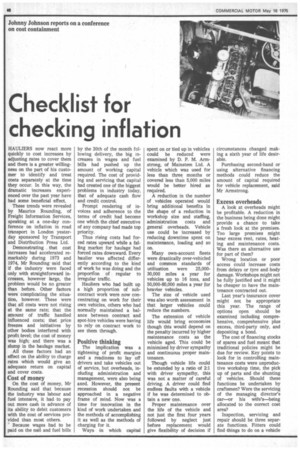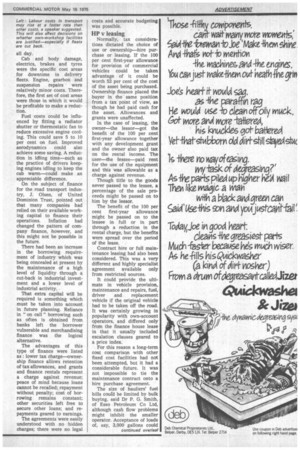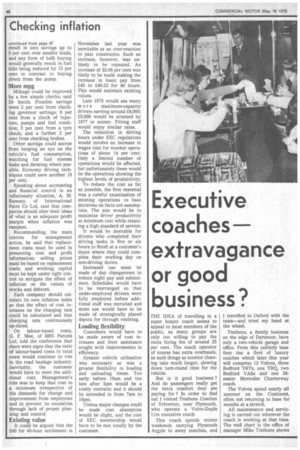Checklist for checking inflation
Page 48

Page 49

Page 50

If you've noticed an error in this article please click here to report it so we can fix it.
HAULIERS now react more quickly to cost increases by adjusting rates to cover them and there is a greater willingness on the part of his customer to identify and treat costs separately at the time they occur. In this way, •the dramatic increases experienced over the past year have had some beneficial effect.
These trends were revealed by Maurice Rounding, of Freight Information Services, speaking at a one-day conference on inflation in road transport in London yesterday sponsored by Transport and Distribution Press Ltd.
Demonstrating that cost increases had accelerated remarkably during 1973 and 1974, Mr Rounding said that if the industry were faced only with straightforward increases, however large, the problem would be no greater than before. Other factors were complicating the situation, however. These were that all costs were not rising at the same rate; that the amount of traffic handled influenced costs; that price freezes and initiatives by other bodies interfered with profit level; the cost of money was high; and there was a slump in the haulage market.
All these factors had an effect on the ability to charge rates which would give an adequate return on capital and cover costs.
Cost of money
On the cost of money, Mr Rounding said that because the industry was labour and fuel intensive, it had to pay out more cash in advance of its ability to debit customers with the cost of services provided than most others.
Because wages had to be paid on the nail and fuel bills by the 20th of the month following delivery, the big increases in wages and fuel bills had pushed up the amount of working capital required. The cost of providing and servicing that capital had created one of the biggest problems in industry today, that of adequate cash flow and credit control.
Prompt rendering of invoices and adherence to •the terms of credit had become one which the chief executive of any company had made top priority.
Thus rising costs had forced rates upward while a falling market for haulage had forced rates downward. Every haulier was affected differently according to the kind of work he was doing and the proportion of regular to irregular traffic.
Hauliers who had built up a high proportion of subcontract work were now concentrating on work for their own vehicles, others who had normally maintained a balance between contract and spot-hire vehicles were having to rely on contract work to see them through.
Positive thinking
The implication was a tightening of profit margins and a readiness to lay off drivers and take vehicles out of service, but overheads, including administration and management, were also being axed. However, the prevent recession should not be approached in a negative frame of mind. Now was a time for innovation in the kind of work undertaken and the methods of accomplishing it as well as the methods of charging for it.
Ways in which capital spent on or tied up in vehicles could be reduced were examined by D. P. M. Armstrong, of Mainstem Ltd. A vehicle which was used for less than three months or covered less than 5,000 miles would be better hired as required.
A reduction in the number of vehicles operated would bring additional benefits in the shape of a reduction in workshop size and staffing, administration costs and general overheads. Vehicle use could be increased by reducing downtime spent on maintenance, loading and so on.
Many own-account fleets were drastically over-vehicled and common standards of utilisation were 25,00030,000 miles a year for vehicles up to 16 tons, and 50,000-60,000 miles a year for heavier vehicles.
The size of vehicle used was also worth assessment in that larger vehicles could reduce the numbers.
The extension of vehicle life would bring economies though this would depend on the penalty incurred by higher maintenance costs as the vehicle aged. This could be minimised by driver sympathy and continuous proper maintenance.
Though vehicle life could be extended by a ratio of 2:1 with driver sympathy, this was not a matter of careful driving. A driver could find endless faults with a vehicle if •he was determined to obtain a new one.
Proper maintenance over the life of the vehicle and not just the first four years followed by neglect just before replacement would give flexibility of decision if circumstances changed making a sixth year of life desirable.
Purchasing second-hand or using alternative financing methods could reduce the amount of capital required for vehicle replacement, said Mr Armstrong.
Excess overheads
A look at overheads might be profitable. A reduction in the business being done might provide a chance to take a fresh look at the premises. Too large premises might bear excess rent, rates, heating and maintenance costs. Was there an alternative use for part of them?
Wrong location or poor access could increase costs from delays or tyre and body damage. Workshops might not be fully justified and it might be cheaper to have the maintenance contracted out.
Last year's insurance cover might not be appropriate this year. The range of options open should be examined including comprehensive, comprehensive plus excess, third-party only, and depositing a bond.
The cost of financing stocks of spares and fuel meant that traditional policies might be due for review. Key points to look for in controlling maintenance costs were unproductive workshop time, the pick up of parts and the shunting of vehicles. Should these functions be undertaken by craftsmen? Were the servicing of the managing director's car—or his wife's—being allocated to the correct cost area?
Inspection, servicing and repair should be three separate functions. Fitters could find things to do on a vehicle
Left: Labour costs in transport may rise at a faster rate than other costs, a speaker suggested. This will also affect decisions on whether own-workshop facilities are justified—especially if fleets are cut back,
all day.
Cab •and body damage, eiectrics, brakes and tyres were the specific cost areas for downtime in delivery fleets. Engine, gearbox and suspension repairs were relatively minor costs. Therefore, the first set of cost areas were those in which it would be profitable to make a reduction.
Fuel costs could be influenced by fitting a radiator shutter or thermostatic fan to reduce excessive engine cooling. This could save 5 to 10 per cent on fuel. Improved aerodynamics could also achieve some saving. A reduction in idling time—such as the practice of drivers keeping engines idling to keep the cab warm—could make an appreciable difference.
On the subject of finance for the road transport industry, J. Olsen, of United Dominion Trust, pointed out that many companies had relied on their available working capital to finance their operations. Inflation had changed the pattern of company finance, however, and this might not be possible in the future.
There had been an increase in the borrowing requirement of industry which was being concealed at present by the maintenance of a high level of liquidity through a cut-back in industrial investment •and a lower level a industrial activity.
That extra capital win be required is something which must be taken into account in future planning. Reliance in"on call" borrowing such as often is obtained from banks left the borrower vulnerable and merchandising finance was the logical alternative.
The advantages of this • type of finance were listed as : lower tax charge—ownership finance allows retention of tax allowances, and grants and finance rentals represent a charge against revenue; peace of mind because loans cannot be recalled; repayment without penalty; cost of borrowing remains constant; other securities left free to secure other loans; and repayments geared to earnings.
The agreements were easily understood with no hidden charges; there were no legal costs and accurate budgeting was possible.
HP v leasing Normally, tax considerations dictated the choice of use or ownership—hire purchase or leasing. If the 100 per cent first-year allowance for provision of commercial vehicles could be taken advantage of it could be worth 52 per cent of the cost of the asset being purchased. Ownership finance placed the buyer in the same position from a tax point of view, as though he had paid cash for the asse't. Allowances and grants were unaffected.
In the case of leasing, the owner—the lessor—got the benefit of the 100 per cent first-year allowance together with any development grant and the owner also paid tax on the rental income. The user—the lessee—paid rent for the use of the equipment and this was allowable as a charge against revenue.
Though title to the goods never passed to the lessee, a percentage of the sale proceeds might be passed on to him by the lessor.
The benefit of the 100 per cent first-year allowance might be passed on to the lessee in full or in part through a reduction in the rental charge, but the benefits were spread over the period of the lease.
Contract hire or full maintenance leasing had also been considered. This was a very different and highly specialist agreement 'available only from restricted sources.
It could provide the ultimate in vehicle provision, maintenance and repairs, fuel, driver and replacement vehicle if the original vehicle had to be taken off the road. It was certainly growing in popularity with own-account operators, and differed only from the finance house lease in that it usually included escalation clauses geared to a price index.
For this reason a long-term cost comparison with other fixed cost facilities had not been attempted, but it had a considerable future. It was not impossible to tie the maintenance contract onto a hire purchase agreement.
The size of hauliers' fuel bills coufd be limited by bulk buying, said Dr P. G. Smith, of Esso Petroleum Co Ltd, although cash flow problems might inhibit the smaller operator. Acceptance of loads of, say, 3,000 gallons could result in unit savings up to 5 per cent over smaller loads, and any form of bulk buying would generally result in fuel bills being reduced by 12 per cent in contrast to buying direct from the pump.
More mpg
Mileage could be improved by a few simple checks, said Dr Smith. Possible savings were 2 per cent from checking governor settings; 8 per cent from a check of injectors, pumps and fuel condition; 3 per cent from a tyre check; and a further 2 per cent from checking brakes.
Other savings could accrue from keeping an eye on the vehicle's fuel consumption, watching for fuel system leaks and derating where possible. Economy driving techniques could save another 15 per cent.
Speaking about accounting and financial control in an inflationary situation, A. M. Ramsey, of International Paint Co Ltd, said that companies should alter their ideas of what is an adequate profit margin when inflation was rampant.
Recommending the main centres for management action, he said that replacement costs must be used in presenting cost and profit information; selling prices must be based on replacement costs; and working capital must be kept under tight control to mitigate the effect of inflation on the values of stocks and debtors.
Each company should calculate its own inflation index so that the effect of cost increases on the charging rate could be calculated and that charging rate continuously up-dated.
On labour-based costs, G. F. Mee, of BRS Parcels Ltd, told the conference that there were signs that the ratio of labour-based costs to total costs would continue to rise in the road haulage industry. Inevitably, the customer would have to meet the additional cost. Management's role was to keep that cost to a minimum irrespective of the demands for change and improvement from employees and to prevent its escalation through lack of proper planning and control.
Existing value
It could be argued that the £40 for 40-hour settlement in November last year was inevitable as an over-reaction to past constraints. Such an increase, however, was unlikely to he repeated. An increase of 32.08 per cent was likely to be made making the increase in basic pay from £40 to £49.22 for 40 hours. This would maintain existing values.
Late 1975 would see many more maximum-capacity drivers earning around £4,000; £5,000 would be attained by 1977 or sooner. Fitting staff • would enjoy similar rates.
The reduction in driving hours under EEC regulations would involve an increase in wages cost for trunker operations of about 14 per cent. Only a limited number of operations would be affected, but unfortunately these would be the operations showing the highest levels of productivity.
To reduce the cost as far as possible, the first essential was a careful examination of existing operations to base decisions on facts not assumpions. The aim would be to maximise driver productivity at minimum cost while retaining a high standard of service.
It would be desirable for drivers who completed their driving tasks in five or six hours to finish at a customer's depot where they could complete their working day on non-driving duties.
Increased use must be made of day changeovers to reduce night pay and subsistence. Schedules would have to be rearranged so that under-employed drivers were fully employed before additional staff was recruited and more use would have to be made of strategically placed depots for through routeing.
Loading flexibility
Customers would have to be made aware of cost increases and their assistance sought with improvements in efficiency.
Greater vehicle utilisation was necessary as was a greater flexibility in loading and unloading times. Too early before 10am and too late after 3pm would be a costly costraint and it should be extended to from 7ana to lOpm.
Unless major changes could be made cost absorption would be slight, and the cost of EEC membership would have to be met totally by the customer.




























































































